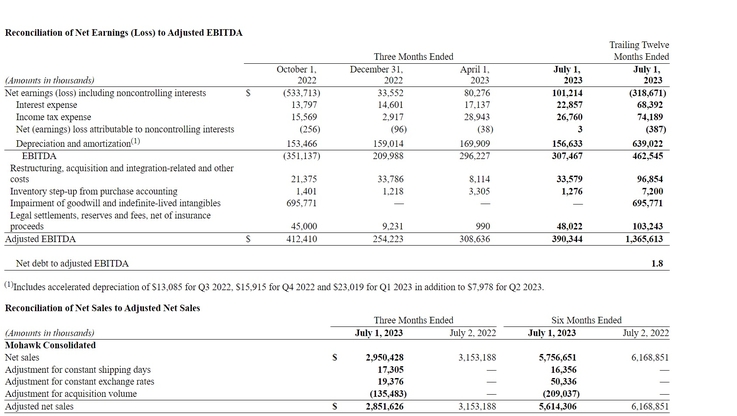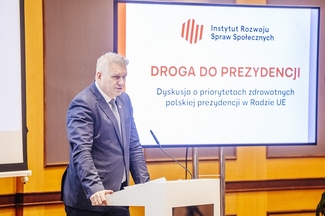Pobierz materiał i Publikuj za darmo
CALHOUN, Ga., July 27, 2023 (GLOBE NEWSWIRE) -- Mohawk Industries, Inc. (NYSE: MHK) today announced second quarter 2023 net earnings of $101 million and diluted earnings per share (“EPS”) of $1.58. Adjusted net earnings were $176 million, and adjusted EPS was $2.76, excluding restructuring, acquisition and other charges. Net sales for the second quarter of 2023 were $3.0 billion, a decrease of 6.4% as reported and 9.6% on a legacy and constant currency and days basis versus the prior year. For the second quarter of 2022, net sales were $3.2 billion, net earnings were $280 million and EPS was $4.40. Adjusted net earnings were $281 million, and adjusted EPS was $4.41, excluding restructuring, acquisition and other charges.
For the six-month period ending July 1, 2023, net earnings and EPS were $181 million and $2.84, respectively. Adjusted net earnings were $288 million, and adjusted EPS was $4.51, excluding restructuring, acquisition and other charges. For the first six months of 2023, net sales were $5.8 billion, a decrease of 6.7% as reported and 9.0% on a legacy and constant currency and days basis versus the prior year. For the six-month period ending July 2, 2022, net sales were $6.2 billion, net earnings were $526 million and EPS was $8.17; adjusted net earnings were $527 million, and adjusted EPS was $8.18, excluding restructuring, acquisition and other charges.
Commenting on Mohawk Industries’ second quarter performance, Jeffrey S. Lorberbaum, Chairman and CEO, stated, “Our margins across the enterprise expanded sequentially due to seasonal improvements, increased production, productivity initiatives and lower input costs. We generated $147 million of free cash flow during the quarter, further strengthening our financial position”.
Typical of housing recessions, higher interest rates and inflation are significantly impacting flooring sales around the world. To manage, we are selectively investing to increase sales and reducing expenses by enhancing productivity, consolidating distribution points and improving administrative efficiencies. In the quarter, we initiated restructuring and integration actions that should save $35 million annually at a total cost of approximately $17 million. We anticipate half of the estimated savings should be realized in the current year, partially offsetting weak residential remodeling activity. In addition, we are limiting future capital investments to those delivering significant sales, margin and operational improvements. In all our regions, we are taking actions to increase sales, including promotions, retailer incentives and selective product launches. The integration of our recent acquisitions is progressing as we combine strategies and enhance their manufacturing and product offering.
Across our regions, we continue to see stronger results in the commercial sector than in residential. Residential remodeling remains the industry's greatest headwind due to lower home sales and deferred home improvement projects. We believe channel inventories have declined and could be at a bottom. Price competition is increasing with declining industry volume, mix and input costs. In the U.S., the housing market remains under pressure due to limited supply, high interest rates and continued inflation. Existing homeowners are not moving at historical levels to maintain their low mortgage rates. In the second quarter, new U.S. home starts increased to an annual rate of 1.45 million, the first quarterly increase since the beginning of last year. We believe the trend in housing starts will continue and will positively impact flooring shipments in the future. In our other regions, home sales and remodeling are also declining due to inflation and interest rates. In Europe, energy prices have continued to decline, though persistent inflation in other categories is limiting consumer remodeling investments. In the quarter, we benefited from the lower energy prices that flowed through our P&L. Our investments in biomass, solar and wind energy production reduce our operational expenses and carbon footprint, positively impacting our performance. The Italian government provided energy subsidies at a reduced level, and the program will not be continued. While managing lower market demand, we are preparing for the rebound that historically follows cyclical declines in our industry. Our porcelain slab, insulation, premium laminate, LVT and quartz countertop manufacturing expansions should deliver the greatest growth as the markets recover.
For the second quarter, the Global Ceramic Segment reported a 0.3% decline in net sales as reported, or a 6.7% decline on a legacy and constant currency and days basis. The Segment’s operating margin was 7.3% as reported, or 8.6% on an adjusted basis, as a result of higher inflation, lower volumes and temporary shutdowns, partially offset by productivity gains and favorable pricing and product mix. Our U.S. ceramic business benefited from a greater participation in the commercial and new construction channels, enhanced designs and more consistent service. We are introducing higher styled products to improve our mix and are focusing on stronger sales channels. We have expanded our customer base, which is helping to offset the weakness in residential remodeling. In our European ceramic business, volumes in the quarter improved sequentially, and our results benefited from sales of premium residential collections, commercial products and exports. We are adjusting to the changing environment and using promotional activities to deliver additional sales volume. As the integration of our acquisitions in Brazil and Mexico proceed, we are realigning the organizations, defining new sales and product strategies and executing cost reductions. The synergies we are realizing are partially offsetting the weakening market conditions, and we have begun to leverage sales of our total product portfolio to expand our distribution.
During the second quarter, our Flooring Rest of the World Segment’s net sales decreased by 11.4% as reported or 10.2% on a legacy and constant currency and days basis. The Segment’s operating margin was 11.0% as reported, or 12.1% on an adjusted basis, as a result of lower volumes, transactional foreign exchange headwinds and temporary shutdowns, partially offset by productivity gains. The Segment continues to successfully manage a difficult environment. Consumer spending has not improved as we expected, with confidence remaining low given inflation, higher interest rates and the war in Ukraine. Though our flooring sales are under pressure, our sheet vinyl collections are outperforming as consumers trade down to lower-priced alternatives. We are aligning laminate and LVT production with present demand and introducing new products, merchandising and specific promotions to expand sales volumes. We have begun to transition our residential LVT offering from flexible to rigid cores and are executing the previously announced restructuring to support this conversion. In panels, fewer projects are being initiated and industrial use has decreased due to slower market conditions. While long-term prospects for our insulation business remain strong, demand is presently declining as residential and commercial investments are being deferred. The Australia and New Zealand housing markets have softened, and we are introducing new products and selective promotions to increase sales volume.
In the second quarter, our Flooring North America Segment sales declined 8.9% as reported or 12.1% on a legacy basis. The Segment's operating margin was 3.7% as reported, or 6.0% on an adjusted basis, as a result of unfavorable pricing and product mix along with reduced volumes and temporary shutdowns, partially offset by lower inflation. The Segment’s second quarter margins sequentially expanded due to seasonality and lower costs flowing through inventory. To control costs, we have enhanced productivity, streamlined administrative functions and initiated restructuring actions. To increase sales, we are initiating selective promotional activity, enhancing our product offering and introducing more consumer-friendly displays. The U.S. commercial sector has proven more resilient as businesses continue to invest in new construction and remodeling projects, though we are experiencing some mix pressure as customers seek to maintain budgets. The July Architectural Billing Index reflected a stable environment for new projects. We continue to see a broader adoption of our waterproof RevWood products in both the retail and builder channels. We have increased the offering of our revolutionary Signature Technology, which accentuates the richness of our Pergo and Karastan laminate collections. We have enhanced our luxury Karastan and Godfrey Hirst residential carpet collections and are providing retailer incentives to grow volumes. Our expanded solution-dyed polyester carpet portfolio is increasing our position with multifamily developers and single home builders, negatively impacting our product mix. We have integrated our recent non-woven acquisition and are improving its sales and operations. Our new rigid LVT introductions with updated visuals, WetProtect and antimicrobial technologies differentiated us in the market, and our sheet vinyl sales rose as consumers selected more affordable options.
Mohawk’s second quarter performance reflected the positive impact of many initiatives we are executing across our business. We are managing the current market conditions while preparing for the rebound in demand that follows cyclical downturns. Central banks have raised interest rates to reduce inflation and are signaling that additional rate hikes are possible. In the U.S., we have seen a rise in builder confidence and housing starts that will increase our residential new construction business. We expect the commercial sector to outperform the residential channel through this year, even with continued weakness in the office category. Though employment remains strong, remodeling and existing home sales are being delayed due to limited housing availability, higher interest rates and inflation. Historically, when the economy recovers, these postponed remodeling projects fuel greater industry growth. Our new restructuring initiatives should save $35 million per year, and our recent acquisitions will add greater benefit to our results as we optimize their performance. In this competitive market, we expect continued pressure on pricing and mix, partially offset by the flow through of lower material and energy costs. Our third quarter seasonally weakens due to summer holidays, lower consumer spending and lower production in Europe. Given these factors, we anticipate our third quarter adjusted EPS to be between $2.62 to $2.72, excluding any restructuring, acquisition and other charges.
At Mohawk, we are taking the necessary steps to manage today's challenges while preparing for tomorrow's opportunities. When central banks shift their focus to a more balanced approach, our business will accelerate as the industry recovers. In all our regions, housing is in short supply, aging homes are in need of remodeling and businesses will invest to grow in more favorable conditions. These factors will create higher growth for flooring, and our investments in capacity expansions and our recent acquisitions will further enhance our results”.
ABOUT MOHAWK INDUSTRIES
Mohawk Industries is the leading global flooring manufacturer that creates products to enhance residential and commercial spaces around the world. Mohawk’s vertically integrated manufacturing and distribution processes provide competitive advantages in the production of carpet, rugs, ceramic tile, laminate, wood, stone and vinyl flooring. Our industry leading innovation has yielded products and technologies that differentiate our brands in the marketplace and satisfy all remodeling and new construction requirements. Our brands are among the most recognized in the industry and include American Olean, Daltile, Durkan, Eliane, Elizabeth, Feltex, GH Commercial, Godfrey Hirst, Grupo Daltile, IVC Commercial, IVC Home, Karastan, Marazzi, Mohawk, Mohawk Group, Mohawk Home, Pergo, Quick-Step, Unilin and Vitromex. During the past decade, Mohawk has transformed its business from an American carpet manufacturer into the world’s largest flooring company with operations in Australia, Brazil, Canada, Europe, Malaysia, Mexico, New Zealand, Russia and the United States.
Certain of the statements in the immediately preceding paragraphs, particularly anticipating future performance, business prospects, growth and operating strategies and similar matters and those that include the words “could,” “should,” “believes,” “anticipates,” “expects,” and “estimates,” or similar expressions constitute “forward-looking statements.” For those statements, Mohawk claims the protection of the safe harbor for forward-looking statements contained in the Private Securities Litigation Reform Act of 1995. There can be no assurance that the forward-looking statements will be accurate because they are based on many assumptions, which involve risks and uncertainties. The following important factors could cause future results to differ: changes in economic or industry conditions; competition; inflation and deflation in freight, raw material prices and other input costs; inflation and deflation in consumer markets; currency fluctuations; energy costs and supply; timing and level of capital expenditures; timing and implementation of price increases for the Company’s products; impairment charges; integration of acquisitions; international operations; introduction of new products; rationalization of operations; taxes and tax reform; product and other claims; litigation; the risks and uncertainty related to the COVID-19 pandemic; regulatory and political changes in the jurisdictions in which the Company does business; and other risks identified in Mohawk’s SEC reports and public announcements.
Conference call Friday, July 28, 2023, at 11:00 AM Eastern Time
To participate in the conference call via the Internet, please visit http://ir.mohawkind.com/events/event-details/mohawk-industries-inc-2nd-quarter-2023-earnings-call. To participate in the conference call via telephone, register in advance at https://dpregister.com/sreg/10180717/f9e2c175dc to receive a unique personal identification number or dial 1-833-630-1962 for U.S./Canada and 1-412-317-1843 for international/local on the day of the call for operator assistance. A replay will be available until August 25, 2023, by dialing 1-877-344-7529 for U.S./Canada calls and 1-412-317-0088 for international/local calls and entering access code #5381723.

The Company supplements its condensed consolidated financial statements, which are prepared and presented in accordance with US GAAP, with certain non-GAAP financial measures. As required by the Securities and Exchange Commission rules, the tables above present a reconciliation of the Company’s non-GAAP financial measures to the most directly comparable US GAAP measure. Each of the non-GAAP measures set forth above should be considered in addition to the comparable US GAAP measure, and may not be comparable to similarly titled measures reported by other companies. The Company believes these non-GAAP measures, when reconciled to the corresponding US GAAP measure, help its investors as follows: Non-GAAP revenue measures that assist in identifying growth trends and in comparisons of revenue with prior and future periods and non-GAAP profitability measures that assist in understanding the long-term profitability trends of the Company's business and in comparisons of its profits with prior and future periods.
The Company excludes certain items from its non-GAAP revenue measures because these items can vary dramatically between periods and can obscure underlying business trends. Items excluded from the Company’s non-GAAP revenue measures include: foreign currency transactions and translation; more or fewer shipping days in a period and the impact of acquisitions.
The Company excludes certain items from its non-GAAP profitability measures because these items may not be indicative of, or are unrelated to, the Company's core operating performance. Items excluded from the Company's non-GAAP profitability measures include: restructuring, acquisition and integration-related and other costs, legal settlements, reserves and fees, net of insurance proceeds, impairment of goodwill and indefinite-lived intangibles, acquisition purchase accounting, including inventory step-up from purchase accounting, release of indemnification assets and the reversal of uncertain tax positions.
CONTACT:
James Brunk
Chief Financial Officer
phone (706) 624-2239
Source: GlobeNewswire
Pobierz materiał i Publikuj za darmo
bezpośredni link do materiału
POBIERZ ZDJĘCIA I MATERIAŁY GRAFICZNE
Zdjęcia i materiały graficzne do bezpłatnego wykorzystania wyłącznie z treścią niniejszej informacji
| Data publikacji | 28.07.2023, 09:56 |
| Źródło informacji | GlobeNewswire |
| Zastrzeżenie | Za materiał opublikowany w serwisie PAP MediaRoom odpowiedzialność ponosi – z zastrzeżeniem postanowień art. 42 ust. 2 ustawy prawo prasowe – jego nadawca, wskazany każdorazowo jako „źródło informacji”. Informacje podpisane źródłem „PAP MediaRoom” są opracowywane przez dziennikarzy PAP we współpracy z firmami lub instytucjami – w ramach umów na obsługę medialną. Wszystkie materiały opublikowane w serwisie PAP MediaRoom mogą być bezpłatnie wykorzystywane przez media. |
Pozostałe z kategorii
Newsletter
Newsletter portalu PAP MediaRoom to przesyłane do odbiorców raz dziennie zestawienie informacji prasowych, komunikatów instytucji oraz artykułów dziennikarskich, które zostały opublikowane na portalu danego dnia.
ZAPISZ SIĘ





